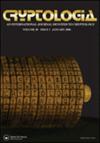UDM:以最少的信息披露进行私有用户发现
IF 0.4
4区 工程技术
Q4 COMPUTER SCIENCE, THEORY & METHODS
引用次数: 3
摘要
摘要:本文提出并分析了一种基于最小信息披露的用户发现协议(UDM)。UDM是一种用于匿名通信系统中用户发现的新协议,它可以最大限度地减少向系统和用户泄露的信息。UDM解决了以下用户发现问题。用户Alice希望通过匿名通信系统(如cMix或Tor)与Bob通信。最初,双方都知道对方的公开联系标识符(如电子邮件地址或电话号码),但都不知道对方在通信系统中的私有平台标识符。如果双方希望彼此通信,UDM使他们能够建立共享秘密并了解彼此的私有平台标识符。与现有的系统(包括那些基于私有集合交集的系统)不同,UDM不了解用户的社会联系,不容易受到暴露联系人列表的离线字典攻击,在没有所有者明确许可的情况下不会向用户透露平台标识符,并且具有较低的计算和通信复杂性。使用匿名通信系统,希望彼此通信的每对用户将他们的私有平台标识符上传到用户发现系统,并使用从他们的共享秘密派生的密钥进行加密。通过从共享密钥派生的加密标签索引他们的请求,每个用户可以下载彼此加密的私有平台标识符。为此,UDM使用一个不受信任的用户发现系统,该系统只处理和存储公共信息或用它不知道的密钥加密的值。因此,从它处理的数据值中,UDM无法了解到任何关于其用户的社交联系的信息。本文章由计算机程序翻译,如有差异,请以英文原文为准。
UDM: Private user discovery with minimal information disclosure
Abstract We present and analyze User Discovery with Minimal information disclosure (UDM), a new protocol for user discovery in anonymous communication systems that minimizes the information disclosed to the system and users. UDM solves the following user-discovery problem. User Alice wishes to communicate with Bob over an anonymous communication system, such as cMix or Tor. Initially, each party knows each other’s public contact identifier (e.g., email address or phone number), but neither knows the other’s private platform identifier in the communication system. If both parties wish to communicate with each other, UDM enables them to establish a shared secret and learn each other’s private platform identifier. Unlike existing systems, including those based on private set intersection, UDM learns nothing about the social contacts of the users, is not vulnerable to off-line dictionary attacks that expose contact lists, does not reveal platform identifiers to users without the owner’s explicit permission, and enjoys low computation and communication complexity. Using the anonymous communication system, each pair of users who wish to communicate with each other uploads to the user-discovery system their private platform identifier, encrypted with a key derived from their shared secret. Indexing their request by a cryptographic tag derived from their shared secret, each user can then download each other’s encrypted private platform identifier. In doing so, UDM uses an untrusted user-discovery system, which processes and stores only public information or values encrypted with keys it does not know. Therefore, from the data values it processes, UDM cannot learn any information about the social contacts of its users.
求助全文
通过发布文献求助,成功后即可免费获取论文全文。
去求助
来源期刊

Cryptologia
工程技术-计算机:理论方法
自引率
33.30%
发文量
31
审稿时长
24 months
期刊介绍:
Cryptologia is the only scholarly journal in the world dealing with the history, the technology, and the effect of the most important form of intelligence in the world today - communications intelligence. It fosters the study of all aspects of cryptology -- technical as well as historical and cultural. The journal"s articles have broken many new paths in intelligence history. They have told for the first time how a special agency prepared information from codebreaking for President Roosevelt, have described the ciphers of Lewis Carroll, revealed details of Hermann Goering"s wiretapping agency, published memoirs - written for it -- of some World War II American codebreakers, disclosed how American codebreaking affected the structure of the United Nations.
 求助内容:
求助内容: 应助结果提醒方式:
应助结果提醒方式:


